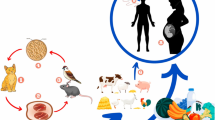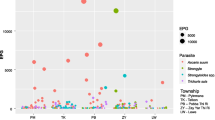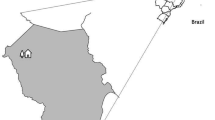Abstract
Anthelmintic treatment is the most common way of controlling nematode infections in ruminants even though several countries have reported anthelmintic resistance (AR), resulting in limitation for sustainable small ruminant production. The aim of the present study was to evaluate the knowledge of resource-poor sheep farmers in Limpopo province of South Africa on the use of anthelmintics. A questionnaire regarding helminthosis control practices was administered to small ruminant farmers in five districts of Limpopo province namely Capricorn, Sekhukhune, Waterberg, Vhembe, and Mopani. A total of 77 resource-poor farmers were interviewed between June and August of 2017 using a structured questionnaire with a combination of qualitative and quantitative open-ended questions. The interviewed farmers were divided into three groups based on their farming experience (< 5; 6–10, and ˃ 10 years of farming experience). Limited farming experience was shown as one of the risks, as farmers that owned sheep for less than 10 years could not identify the symptoms of gastrointestinal parasites infection and did not know how nematodes are transmitted to animals. However, no significant difference (p < 0.05) was found to exist between the three groups of farmers in terms of clinical signs identification and correct application of anthelmintics. About 43% of the respondents were unaware of gastrointestinal nematodes (GI) that infect sheep, could not identify the clinical symptoms of gastrointestinal nematodes infection, and only 34% knew how animals become infected. Although 67.5% of farmers mentioned that they never dose their sheep, 32.5% use anthelmintics at varying times in a year. None of the farmers weighed their sheep before dosing them instead visual appraisal of individual weight was the most common means of estimating the anthelmintic dose. The above information is an indication of risks associated with possible occurrence of anthelmintic resistance in the study areas. There is therefore, a need to give training to resource-poor farmers of small stock on proper application of anthelmintic treatment and to educate them on how to prevent development of AR. Future studies on AR should also be conducted in the province in flocks with high-treatment frequencies to establish the occurrence of AR using both in vivo and in vitro methods. The most common risk factor associated with the occurrence of AR in all the five districts of Limpopo province was found to be the use of anthelmintics without weighing the animals to determine the correct dosage.


Similar content being viewed by others
References
Aga, T.S., Tolossa, Y.H. and Terefe, G., 2013. Parasite control practices and anthelmintic efficacy field study on gastrointestinal nematode infections of Horro sheep in Western Oromiya, Ethiopia. African Journal of Pharmacy and Pharmacology, 7(47):2972–2980.
Akpalu, D.A., 2013. Agriculture extension service delivery in a semi-arid rural area in South Africa: the case study of Thorndale in the Limpopo Province. African Journal of Food, Agriculture, Nutrition and Development, 13(4):8034–8057.
Álvarez-Sánchez, M.A., Mainar-Jaime, R.C., Pérez-García, J., Monteagudo-Rodríguez, M. and Martín-Gómez, S., 2001. Anthelmintic resistance in small-ruminant flocks in Spain: extension in the Leon province (NW). In Abstracts to the 18th International Conference of the World Association for the Advancement of Veterinary Parasitology August 26–30, 2001, Stresa, Italy, 2001, pp.155.
Anon 2007. Pietersburg: The Columbia Encyclopaedia, (6th edition) Columbia University Press. [Online] Available: www.encyclopedia.com (April 4, 2008).
Bakunzi, F.R., 2003. Anthelminic resistance of nematodes in communally grazed goats in a semi-arid area of South Africa. Journal of the South African Veterinary Association, 74, 82–83.
Belina, D., Giri, A., Mengistu, S. and Eshetu, A., 2017. Gastrointestinal Nematodes in Ruminants: The Parasite Burden, Associated Risk Factors and Anthelmintic Utilization Practices in Selected Districts of East and Western Hararghe, Ethiopia. Journal of Veterinary Science and Technology, 8:2.
Borgsteede, F.H.M., Dercksen, D.D. and Huijbers, R., 2007. Doramectin and albendazole resistance in sheep in the Netherlands. Veterinary Parasitology, 144: 180–183. DOI: https://doi.org/10.1016/j.vetpar.2006.09.031.
Čerñanská, D., Várady, M. and Čorba, J., 2006. A survey on anthelmintic resistance in nematode parasites of sheep in the Slovak Republic. Veterinary Parasitology, 135: 39–45. DOI: https://doi.org/10.1016/j.vetpar.2005.09.001.
Čerñanská, D., Várady, M., Čudeková, P. and Čorba, J., 2008. Worm control practices on sheep farms in the Slovak Republic. Veterinary Parasitology, 154: 270–276. DOI: https://doi.org/10.1016/j.vetpar.2008.03.026.
Cezar, A.S., Toscan, G., Camillo, G., Sangioni, L.A., Ribas, H.O. and Vogel, F.S.F., 2010. Multiple resistance of gastrointestinal nematodes to nine different drugs in a sheep flock in southern Brazil. Veterinary Parasitology, 173: 157–160. DOI: https://doi.org/10.1016/j.vetpar.2010.06.013.
Chartier, C., Soubirac, F., Pors, I., Silvestre, A. and Hubert, J., 2001. Prevalence of anthelmintic resistance in gastrointestinal nematodes of dairy goats under extensive management conditions in southwestern France. Journal of Helminthology, 75: 325–330.
Cook, C., Reason, C.J.C. and Hewitson, B.C., 2004. Wet and dry spells within particularly wet and dry summers in the South African summer rainfall region. Climate Research, 26: 17–31. doi:https://doi.org/10.3354/cr026017.
Dagnachew, S., Tsegaye, B., Awukew, A., Tilahun, M., Ashenafi, H., Rowan, T., Abebe, G., Barry, D.J., Terefe, G. and Goddeeris, B.M., 2017. Prevalence of bovine trypanosomosis and assessment of trypanocidal drug resistance in tsetse infested and non-tsetse infested areas of Northwest Ethiopia. Parasite Epidemiology and Control, 2(2): 40–49. https://doi.org/10.1016/j.parepi.2017.02.002.
Dolinská, M., Königová, A. and Várady, M., 2012. Is the micro-agar larval development test reliable enough to detect ivermectin resistance?. Parasitology Research, 111: 2201–2204. DOI: https://doi.org/10.1007/s00436012-2944-4.
Domke, A.V.M, Chartier, C., Gjerde, B., Leine, N., Vatn, S., Østerås, O., Stuen, S., 2011. Worm control practice against gastro-intestinal parasites in Norwegian sheep and goat flocks. Acta Veterinaria Scandinavica, 53 (1):29. https://doi.org/10.1186/1751-0147-53-29.
Ferguson, D., Lee, Caroline. and Fisher, A. 2017. Advances in sheep welfare (Woodhead publishing, United Kingdom).
Geurden, T., Hoste, H., Jacquiet, P., Traversa, D., Sotiraki, S., di Regalbono, A.F., Tzanidakis, N., Kostopoulou, D., Gaillac, C., Privat, S., Giangaspero, A., Zanardello, C., Noe, L., Vanimisetti, B., Bartram, D. and 2014. Anthelmintic resistance and multidrug resistance in sheep gastro-intestinal nematodes in France, Greece and Italy. Veterinary Parasitology, 201, 59–66.
Jackson, F., 2009. Worm control in sheep in the future. Small Ruminant Research, 86: 40–45.
Kumsa, B., Tolera, A. and Nurfeta, A., 2010. Comparative efficacy of seven brands of Albendazole against naturally acquired gastrointestinal nematodes in sheep in Hawassa, southern Ethiopia. Turkish Journal of Veterinary & Animal Sciences, 34(5):417–425. https://doi.org/10.3906/vet-0712-28.
Kupčinskas, T., Stadalienė, I., Šalomskas, A., Trusevičius, P. and Varady, M., 2016. Worm-control practices and prevalence of anthelmintic resistance using in vivo FECRTs on smallholder sheep farms in Lithuania. Helminthologia, 53(1): 24–30.
Limpopo Department of Agriculture, 2008. Background. [Online] Available: http://www.lda.gov.za/index.php?option=com_content&view=article&id=60&Itemid=55 (April 4, 2008).
Limpopo Local Government, 2012. The Mapping of Agricultural Commodity Production in the Limpopo province, South Africa.
Martínez-Valladares, M., Martínez-Pérez, J.M., Robles-Pérez, D., Cordero-Pérez, C. and Famularo, M.R., 2013. The present status of anthelmintic resistance in gastrointestinal nematode infections of sheep in the northwest of Spain by in vivo and in vitro techniques. Veterinary Parasitology, 191: 177–181. DOI: https://doi.org/10.1016/j.vetpar.2012.08.009.
McMahon, C., Edgar, H.W., Barley, J.P., Hanna, R.E.B, Brennan, G.P. and Fairweather, I., 2017. Control of Nematidirus spp. Infection by sheep flock owners in Northern Ireland. Irish Veterinary Journal, 70:31. DOI https://doi.org/10.1186/s13620-0109-6.
Mohammed, A., Disassa, H., Kabeta, T., Zenebe, T. and Kebede, G., 2015. Prevalence of Gastrointestinal Nematodes of Sheep in Gursum Woreda of Eastern Hararghe Zone, Oromia Regional State, Ethiopia. Researcher, 7: 45–54.
Mohammed, K., Abba, Y. and Ramli, N.S.B., 2016. The use of FAMACHA in estimation of gastro intestinal nematodes and total worm burden in Damara and Barbados Blackbelly cross sheep. Tropical Animal Health and Production, 48(5): 1013–1020. https://doi.org/10.1155/2018/9247439.
Papadopoulos, E., 2008. Anthelmintic resistance in sheep nematodes. Small Ruminants Research, 76: 99–103. DOI: https://doi.org/10.1016/j.smallrumres.2007.12.012.
Papadopoulos, E., Gallidis, E. and Ptochos, S., 2012. Anthelmintic resistance in sheep in Europe: A selected review. Veterinary Parasitology, 189(1):85–88. DOI: https://doi.org/10.1016/j.vetpar.2012.03.036.
Sangster, N.C., Cowling, A. and Woodgate, R.G., 2018. Ten events that defined anthelmintic resistance research. Trends in Parasitology, 34: 553–563. https://doi.org/10.1016/j.pt.2018.05.001.
Sargison, N.D., 2011. Pharmaceutical Control of Endoparasitic Helminth Infections in Sheep. Veterinary Clinics of North America: Food and Animal practice, 27: 139–156.
Sargison, N.D., 2016. Keys to solving problems in small ruminants: Anthelmintic resistance as a threat to sustainable nematode control. Small Ruminant Research, 142:11–15.
Sargison, N.D., Jackson, F., Bartley, D.J., Wilson, D.J., Stenhouse, L.J. and Penny, C.D., 2007. Observations on the emergence of multiple anthelmintic resistance in sheep flocks in the south-east of Scotland. Veterinary Parasitology, 145:65–76.
Taylor, M.A., Learmount, J., Lunn, E., Morgan, C. and Craig, B.H., 2009. Multiple resistance to anthelmintics in sheep nematodes and comparison of methods used for their detection. Small Ruminants Research 86:67–70. DOI: https://doi.org/10.1016/j.smallrumres.2009.09.020.
Thomas, D.S.G., Twyman, C., Osbahr, H. and Hewiston, B., 2005. Adapting to climate change and variability in Limpopo.
Torres-Acosta, J.F.J., Mendoza-De-Gives, P., Aguilar-Caballero, A.J. and Cué Llar-Ordaz, J.A., 2012. Anthelmintic resistance in sheep farms: update of the situation in the American continent. Veterinary Parasitology, 189:89–96. DOI:https://doi.org/10.1016/j.vetpar.2012.03.037.
Tsotetsi, A.M, Njiro, S., Katsande, T.C., Mayo, G. and Baloyi, F., 2013. Prevalence of gastrointestinal helminths and anthelmintic resistance on small-scale farms in Gauteng Province, South Africa. Tropical Animal Health and Production, 45(3):751–761.
Van Wyk, J.A., 2001. Refugia – overlooked as perhaps the most potent factor concerning the development of anthelmintic resistance. Onderstepoort Journal of Veterinary Research 68, 55–67.
Van Wyk, J.A., Malan, F.S. and Bath, G.F., 1997. Rampant anthelmintic resistance in sheep in South Africa – what are the options?
Van Wyk, J.A., Stetson, M.O., Van Der Merwe, J.S, Vorster R.J. and Viljoen, P.G. 1999. Anthelmintic resiatance in South Africa: Surveys indicate an extremely serious situation in sheep and goat farming. Onderstepoort Journal of Veterinary Research, 66:273–284.
Vatta, A.F. and Lindberg, A.L.E., 2006. Managing anthelmintic resistance in small ruminant livestock of resource-poor farmers in South Africa Review article.
Vijayasarathi, M.K., Sreekumar, C., Venkataramanan, R. and Raman, M. 2016. Influence of sustained deworming pressure on the anthelmintic resistance status in strongyles of sheep under field conditions. Tropical Animal Health and Production, 48: 1455–1462.
Wolstenholme, A.J., Fairweather, I., Prichard, R., von Samson-Himmelstjerna, G. and Sangster, N.C., 2004. Drug resistance in veterinary helminths. Trends in Parasitology, 20:469–476.
World Health Organisation, 2014. Antimicrobial resistance: global report on surveillance.
Acknowledgements
The first author is supported by a grant holder bursary of the Collaborative Postgraduate Training Grant of National Research Foundation (NRF) of South Africa (GUN: 105271) made available to OMMT. This study was made possible by the funding from Afrivet Chair on Primary Animal Health Care (University of Pretoria) research grant made available to RM and the NRF incentive grant for rated researchers (GUN94187) made available to OMMT. The authors acknowledge the sheep farmers in the five district municipalities of Limpopo province, extension officers, and animal health technicians in the Limpopo Department of Agriculture for their cooperation. We are grateful to the animal production interns at Tompi Seleka College of Agriculture for their technical assistance during data collection.
Funding
The first author is supported by a grant holder bursary of the Collaborative Postgraduate Training Grant of National Research Foundation (NRF) of South Africa (GUN:105271) made available to OMMT. This study was made possible by the funding from Afrivet Chair on Primary Animal Health Care (University of Pretoria) research grant made available to RM and the NRF incentive grant for rated researchers (GUN94187) made available to OMMT.
Author information
Authors and Affiliations
Contributions
MM, AMT-K, RM, and OMMT planned the study. MM conducted the experiment and drafted the manuscript. AMT-K, RM, and OMMT reviewed the manuscript. MLM conducted statistical analysis.
Corresponding author
Ethics declarations
Competing interests
The authors declare that they have no competing interests.
Rights and permissions
About this article
Cite this article
Mphahlele, M., Tsotetsi-Khambule, A.M., Moerane, R. et al. Risk factors associated with occurrence of anthelmintic resistance in sheep of resource-poor farmers in Limpopo province, South Africa. Trop Anim Health Prod 51, 555–563 (2019). https://doi.org/10.1007/s11250-018-1724-2
Received:
Accepted:
Published:
Issue Date:
DOI: https://doi.org/10.1007/s11250-018-1724-2




